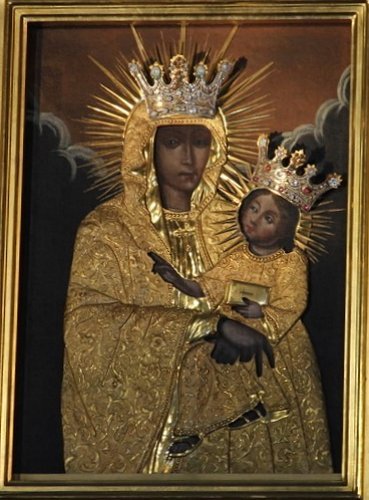Czarna
Our Lady the Teacher
(Matka Boza Wychowawczyni)
In her sanctuary in the village Czarna, 26-220 Staporków, near Konskie, (careful: there are 12 towns and villages, plus a river by the name of Czarna, which means black) about 2 hours and 130 km North-East of Czestochowa, late 16th/early 17th century, oil on canvas.
This is what happens when you google translate and search Polish websites for Black Madonnas: you find a miraculous dark Mother of God, who fits almost all the criteria for being a Black Madonna, except she doesn’t actually bear that title, she’s just from a village called Black, on a river called Black (Czarna in Polish)! Oh well, looks like she’d be worth a visit for a devotee of the Dark Mother, so I will include her in my index.
Here’s what I gather from the images and the google translation: at the turn of the 16th to the 17th century, Mary appeared in a grove of juniper trees on the banks of the river to a group of workers making charcoal. Whether that means Mary in form of this icon or Mary in form of a celestial apparition is not clear, but it is common in Black Madonna legends to treat the miraculous apparition of an image of Mary as an apparition of her very self.
It didn’t take long for the villagers to build a little wooden chapel right on the spot of the apparition and to install in it this beautiful painting by an unknown artist.
The work is a copy of the famous icon in Rome called Salus Populi Romani, i.e. the Salvation of the Roman People. She too is lacking the title Black Madonna although Ean Begg and the Catholic University of Dayton both list her in their index of Black Madonnas. Beginning in the 16th century, the Jesuits used this image as part of their counter-reformation and spread copies and devotion to her all around the world.¹ Although this Roman lady differs from the normal type of Mary icon that is known as Hodegetria (Greek: Guide of the Way), she was classified as such. Hence her Polish title: Our Lady the Teacher.
Her gesture of the upside down blessing that looks almost like a secret, barely noticeable gang sign, is unique to Salus Populi Romani. Also kind of secretly, the original holds a barely noticeable handkerchief. It’s an embroidered ceremonial cloth called a mappa or mappula and it signifies imperial power.² In the Polish icon the mappa is covered by the riza, the precious metal cover that protects important Eastern European icons. Interesting how Mary somewhat hides her power to bless and to rule in plain sight! I think this is very significant...
But back to Poland. News of the supernatural apparition of the image and ensuing graces and miracles kept spreading and the parish grew. The first chapel became too small to accommodate the crowds of pilgrims. So in 1763 a wealthy lady, Isabella Malachowska, commissioned the construction of the first brick church. But still the crowds and parish kept growing and so at the beginning of the twentieth century the present, even larger church was erected. Work began in 1909. Because of World War I it took until 1930 to finish.
In 1999, after 19 years of jumping through the necessary Catholic hoops and preparations, Our Lady the Teacher was canonically crowned. The crown had already been blessed by Pope John Paul II in 1991 on one of his pilgrimages to his homeland.
The icon was renovated and cleaned in 1990/91 and again in 1997. She must have been really black before that.
Daily masses are held at 5:00 p.m., Sunday masses at 8:30 and 11:00 a.m. and 5:00 p.m. Since the 1970’s the sanctuary and parish is under the care of an order called the Pallottines. That likely means that the church is open all day.
The Teacher’s feast days are celebrated on Pentecost and on the day that commemorates her arrival in the parish and her coronation: the first Sunday of September.
Footnotes:
1. http://en.wikipedia.org/wiki/Salus_Populi_Romani
2. http://en.wikipedia.org/wiki/Salus_Populi_Romani#Description
Sources for article: http://konskie.travel and http://sanktuariapolskie.info





